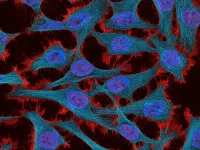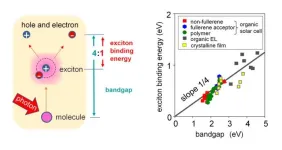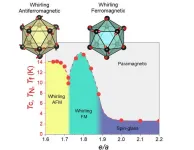(Press-News.org) In a groundbreaking study published on January 18, 2024, in Cancer Discovery, scientists at University of California San Diego School of Medicine leveraged a machine learning algorithm to tackle one of the biggest challenges facing cancer researchers: predicting when cancer will resist chemotherapy.
All cells, including cancer cells, rely on complex molecular machinery to replicate DNA as part of normal cell division. Most chemotherapies work by disrupting this DNA replication machinery in rapidly dividing tumor cells. While scientists recognize that a tumor's genetic composition heavily influences its specific drug response, the vast multitude of mutations found within tumors has made prediction of drug resistance a challenging prospect.
The new algorithm overcomes this barrier by exploring how numerous genetic mutations collectively influence a tumor's reaction to drugs that impede DNA replication. Specifically, they tested their model on cervical cancer tumors, successfully forecasting responses to cisplatin, one of the most common chemotherapy drugs. The model was able to identify tumors at most risk for treatment resistance and was also able to identify much of the underlying molecular machinery driving treatment resistance.
"Clinicians were previously aware of a few individual mutations that are associated with treatment resistance, but these isolated mutations tended to lack significant predictive value. The reason is that a much larger number of mutations can shape a tumor's treatment response than previously appreciated," Trey Ideker, PhD, professor in Department of Medicine at UC San Diego of Medicine, explained. "Artificial intelligence bridges that gap in our understanding, enabling us to analyze a complex array of thousands of mutations at once."
One of the challenges in understanding how tumors respond to drugs is the inherent complexity of DNA replication — a mechanism targeted by numerous cancer drugs.
“Hundreds of proteins work together in complex arrangements to replicate DNA," Ideker noted. "Mutations in any one part of this system can change how the entire tumor responds to chemotherapy.”
The researchers focused on the standard set of 718 genes commonly used in clinical genetic testing for cancer classification, using mutations within these genes as the initial input for their machine learning model. After training it with publicly accessible drug response data, the model pinpointed 41 molecular assemblies — groups of collaborating proteins — where genetic alterations influence drug efficacy.
“Cancer is a network-based disease driven by many interconnected components, but previous machine learning models for predicting treatment resistance don’t always reflect this,” said Ideker. "Rather than focusing on a single gene or protein, our model evaluates the broader biochemical networks vital for cancer survival."
After training their model, the researchers put it to the test in cervical cancer, in which roughly 35% of tumors persist after treatment. The model was able to accurately identify tumors that were susceptible to therapy, which were associated with improved patient outcomes. The model also effectively pinpointed tumors likely to resist treatment.
Further still, beyond forecasting treatment responses, the model helped shed light on its decision-making process by identifying the protein assemblies driving treatment resistance in cervical cancer. The researchers emphasize that this aspect of the model — the ability to interpret its reasoning — is key to the model’s success and also for building trustworthy AI systems.
"Unraveling an AI model's decision-making process is crucial, sometimes as important as the prediction itself," said Ideker. "Our model's transparency is one of its strengths, first because it builds trust in the model, and second because each of these molecular assemblies we’ve identified becomes a potential new target for chemotherapy. We’re optimistic that our model will have broad applications in not only enhancing current cancer treatment, but also in pioneering new ones."
Full link to study: https://aacrjournals.org/cancerdiscovery/article/doi/10.1158/2159-8290.CD-23-0641/733374/Cancer-mutations-converge-on-a-collection-of
Co-authors of the study include: Xiaoyu Zhao, Akshat Singhal, Sungjoon Park, JungHo Kong and Robin E. Bachelder, all at UC San Diego.
This study was supported by the National Institutes of Health (NCI U54 CA274502 and P41 GM103504), Merck KGaA and the Eric and Wendy Schmidt AI in Science Postdoctoral Fellowship, a Schmidt Futures program.
###
END
AI harnesses tumor genetics to predict treatment response
There are many paths to cancer resistance; AI can decode them all simultaneously
2024-01-18
ELSE PRESS RELEASES FROM THIS DATE:
AMS 2024 Annual Meeting highlights climate challenges and solutions
2024-01-18
[Boston, MA—January 18, 2023] The American Meteorological Society’s (AMS) 104th Annual Meeting will gather thousands of people at the Baltimore Convention Center 28 January–1 February to attend the world’s largest annual meeting focused on weather, water, and climate. The AMS is the professional society for everyone in the atmospheric and hydrologic sciences and services, including meteorologists, research scientists, emergency managers, academics, weather broadcasters, and more.
“The theme of our 104th Annual Meeting is ‘Living in a Changing Environment,’” says AMS President Brad Colman. “It’s ...
Tackling antibiotic resistance when treating pneumonia
2024-01-18
New research has been published that identifies positive steps towards a better understanding of antimicrobial resistance (AMR), specifically in hospital-acquired pneumonia (HAP).
Antimicrobial, or antibiotic resistance, is a growing global issue, yet little is known about how to dose antibiotics to minimise bacteria developing resistance in patients. However, the University of Liverpool is playing a key role in contributing to international efforts to better understand AMR.
In a paper published today (Thursday 18 January), ...
Stuck in traffic: Researchers identify cellular traffic jams in a rare disease
2024-01-18
Researchers from McGill University, led by Professor Alanna Watt of the Department of Biology, have identified previously unknown changes in brain cells affected by a neurological disease. Their research, published in eLife, could pave the way to future treatments for the disease.
Spinocerebellar ataxia type 6, known as SCA6, is a rare neurological disease that disrupts the function in a part of the brain called the cerebellum, causing difficulties with movement and coordination. The condition results from genetic mutations, ...
Study examines substance use in first responders during the COVID-19 pandemic
2024-01-18
Considerable attention has focused on burnout and mental health of physicians and nurses on the frontline during the COVID-19 pandemic. First responders – law enforcement personnel, firefighters and emergency medical service (EMS) providers, also experienced increased levels of stress, anxiety and depression due to job-related pressures associated with the pandemic.
Given their exposure to work-related stress during this time, first responders may have been at considerable risk of developing problematic substance use. However, little is known about the factors associated with first responder drug and alcohol use during the pandemic.
A study by Florida ...
Lighting the path: Exploring exciton binding energies in organic semiconductors
2024-01-18
Organic semiconductors are a class of materials that find applications in various electronic devices owing to their unique properties. One attribute that influences the optoelectronic property of these organic semiconductors is their "exciton binding energy," which is the energy needed to divide an exciton into its negative and positive constituents. Since high binding energies can have a significant impact on the functioning of optoelectronic devices, low binding energies are desirable. This can help in reducing energy losses in devices like organic solar cells. While several methods for designing organic materials with low binding energies have ...
Unlocking the secrets of quasicrystal magnetism: revealing a novel magnetic phase diagram
2024-01-18
Quasicrystals are intermetallic materials that have garnered significant attention from researchers aiming to advance condensed matter physics understanding. Unlike normal crystals, in which atoms are arranged in an ordered repeating pattern, quasicrystals have non-repeating ordered patterns of atoms. Their unique structure leads to many exotic and interesting properties, which are particularly useful for practical applications in spintronics and magnetic refrigeration.
A unique quasicrystal variant, known as the Tsai-type icosahedral quasicrystal (iQC) and their cubic approximant crystals (ACs), display intriguing characteristics. These include long-range ferromagnetic (FM) ...
DNA construction led to unexpected discovery of important cell function
2024-01-18
Researchers at Karolinska Institutet in Sweden have used DNA origami, the art of folding DNA into desired structures, to show how an important cell receptor can be activated in a previously unknown way. The result opens new avenues for understanding how the Notch signalling pathway works and how it is involved in several serious diseases. The study is published in Nature Communications.
Notch is a cell receptor that is of great importance to a wide range of organisms and plays a crucial role in many different processes, including early embryonic development in both flies and humans. Notch ...
Why animals shrink over time explained with new evolution theory
2024-01-18
The mystery behind why Alaskan horses, cryptodiran turtles and island lizards shrunk over time may have been solved in a new study.
The new theoretical research proposes that animal size over time depends on two key ecological factors: the intensity of direct competition for resources between species, and the risk of extinction from the environment.
Using computer models simulating evolution, the study, published today (Thursday, 18 January) in communications biology, identifies why some species gradually get smaller, as indicated by fossil records.
Dr Shovonlal Roy, an ecosystem modeller from the University of Reading who led the research, ...
CD19-targeted CAR NK cell therapy achieves promising one-year results in patients with B-cell malignancies
2024-01-18
Researchers from The University of Texas MD Anderson Cancer Center reported promising results in a Phase I/II trial of 37 patients with relapsed or refractory B-cell malignancies who were treated with cord blood-derived chimeric antigen receptor (CAR) natural killer (NK) cell therapy targeting CD19.
Published today in Nature Medicine, the findings reveal an overall response (OR) rate of 48.6% at 100 days post treatment, with one-year progression-free survival (PFS) and overall survival (OS) rates of 32% & 68%, respectively. The trial reported an excellent safety profile with no cases of severe cytokine release syndrome (CRS), neurotoxicity, ...
New cause of neuron death in Alzheimer's discovered
2024-01-18
· New finding to understand brain cell loss in neurodegenerative disease
· Increasing protective short RNAs may be new approach to halt or delay Alzheimer’s
· SuperAgers with superior memories have more protective short RNAs in their brains
CHICAGO --- Alzheimer’s disease, which is expected to have affected about 6.7 million patients in the U.S. in 2023, results in a substantial loss of brain cells. But the events that cause neuron death are poorly understood.
A new Northwestern Medicine study shows that RNA interference may play a key role in Alzheimer’s. For the first time, ...
LAST 30 PRESS RELEASES:
World-first discovery uncovers how glioblastoma tumours dodge chemotherapy, potentially opening the door to new treatments
A fatal mix-up: How certain gut bacteria drive multiple sclerosis
New AI tool identifies not just genetic mutations, but the diseases they may cause
Deep-learning model predicts how fruit flies form, cell by cell
Combination pills for high blood pressure may simplify treatment, improve long-term health
Immune system keeps mucosal fungi in check
Neurons within the brain use simple rules to localize genetic messages
Electrodes created using light
Second-hand gift-giving is a well-deliberated decision
How human interaction drove evolution to make bears less aggressive
National Poll: Few parents offer teens guidance on healthy eating during holiday season
Cannabis derivatives could provide new ovarian cancer treatments
Raising strong yeast as a petroleum substitute
Clues to the origin of hot Jupiters hidden in their orbits
Canada’s reduced pledge to Global Fund will impact domestic health
1 in 4 children with major traumatic injuries not cared for in pediatric trauma centres
Duke and Duke-NUS’ joint cross-population research to uncover "East-West" differences in disease and care
Scientists to ‘spy’ on cancer- immune cell interactions using quantum technology breakthrough
Tech savvy users have most digital concerns
Making lighter work of calculating fluid and heat flow
Normalizing blood sugar can halve heart attack risk
Lowering blood sugar cuts heart attack risk in people with prediabetes
Study links genetic variants to risk of blinding eye disease in premature infants
Non-opioid ‘pain sponge’ therapy halts cartilage degeneration and relieves chronic pain
AI can pick up cultural values by mimicking how kids learn
China’s ecological redlines offer fast track to 30 x 30 global conservation goal
Invisible indoor threats: emerging household contaminants and their growing risks to human health
Adding antibody treatment to chemo boosts outcomes for children with rare cancer
Germline pathogenic variants among women without a history of breast cancer
Tanning beds triple melanoma risk, potentially causing broad DNA damage
[Press-News.org] AI harnesses tumor genetics to predict treatment responseThere are many paths to cancer resistance; AI can decode them all simultaneously



